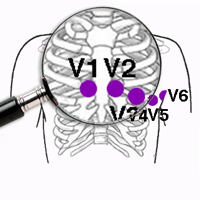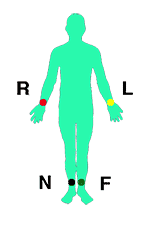How To Remove Ekg Stickers
Tips for Placing the Electrocardiogram Electrodes

With this article we are trying to give yous some tricks for placing electrocardiogram electrodes. Tricks and recommendations that we have collected from our experience, every bit well as those of several colleagues from the My EKG team.
Nosotros promise that these tips, which are and then simple that they are sometimes disregarded, are useful in your daily work.
Tips for Correctly Performing an EKG
Related commodity: How to perform an electrocardiogram.
Offset Trick: Uncover chest, ankles and easily.

Prototype courtesy of imagerymajestic / FreeDigitalPhotos.internet
It is of import to remove all garments that cover the chest, wrists or ankles, as well every bit other objects present in the areas where the electrodes are placed, because they brand it more than difficult to obtain the EKG correctly.
Women will always be instructed to remove their bra, otherwise, information technology is necessary to place the precordial electrodes below the 5th intercostal space. If that occurs, the EKG would be poorly performed.
Other objects on the ankles and wrists, such as chains or watches, must also exist removed and cell phones or electronic devices must be set aside. All of this improves the quality of the electrocardiogram, decreasing the advent of artifacts.
Second Trick: Assure the patient's nobility.
This is the main complaint of patients in social networks, especially by women.
While we have recommended to completely undress the chest as the get-go advice, this should exist washed while assuring the dignity of the patient.
It is advisable to evangelize a hospital gown or at least cover the breast with a sheet while the electrocardiogram is performed, provided information technology is not in contact with the electrodes.
Third Trick: If there is hair, shave it.

Image courtesy of Keerati / FreeDigitalPhotos.net
This is another point that is often forgotten, because in patients with a lot of hair on their breast it is clear that you must shave it, merely we too recommend shaving even if the patient has footling hair.
Why? For two reasons:
Information technology guarantees a ameliorate contact of the electrode with the skin and above all (very important) you salve the patient from a painful hair removal when removing the electrode.
Fourth Trick: Clean the electrode placement zones.
Fully recommended for all patients. Non because they come dirty (some practice, we aren't going to lie), but because sweat, perfumes, or creams, decrease the adhesion of the electrodes, worsening the quality of the EKG, and therefore its correct estimation.
You lot can clean the peel with gauze soaked in alcohol solution or simply with a towel.
More information: How to perform an electrocardiogram.
Tricks for correctly placing the electrodes
Related article: Electrocardiogram electrodes.
There are two color codes for the electrodes, the International Electrotechnical Commission (IEC) and the American Heart Association (AHA).

Limb Electrodes:
Currently we don't have a trick for the color lawmaking of the AHA, just we do take one for the IEC.
The colors of the peripheral electrodes of the IEC are reminiscent of the traffic lite: red, yellow and green, since they are placed in that order in the clockwise management.
Starting with the right arm (carmine), left arm (yellow), left leg (greenish), right leg (Black). It'southward that easy.
Precordial Electrodes:
In the precordial electrodes the location is more important than the colors.
The nigh frequent question is: how practice I locate the fourth intercostal space? Our advice is to count the spaces betwixt the ribs along the border of the sternum until you achieve the fourth.
In one case y'all accept followed our trick, place V1 and V2 on the right and left edges of the sternum in the 4th intercostal space.
Side by side trick: place V4 earlier V3.
Where? In an intercostal space lower than V2, on the imaginary line that descends from the middle of the clavicle. Now place V3, right at the midpoint of the line going from V2 to V4.
And finally, V5 and V6 become in line with V4 on the anterior axillary line and on the midaxillary line respectively (read location of the EKG electrodes).
More data: Electrocardiogram electrodes.
Tricks with different types of electrodes
Suction cup type: attempt to make a suitable suction to set up the electrode, but avoid excessive suction, because it can go out redness or fifty-fifty bruises.
Clothespin type: over time, the quality of contact with the skin may decrease, we recommend moistening the electrode with an booze solution to increase the conduction, improving the EKG effect.
Prune type: always shave when necessary (don't forget information technology). Connect the cablevision and the electrode before placing the electrode on the patient, doing then after results in putting pressure against the patient'south peel (and sometimes against the ribs) which can exist painful.
Seal type: shave the patient. Ensure a right "bite" of the clamps on the electrode's ear, equally they usually deteriorate with utilize.
We promise that these tricks or tips for placing electrocardiogram electrodes have been useful to you, as we collect more, we volition update this article.
If you know another 1 that we accept not picked up on, do not hesitate to tell the states through social media and we will happily include information technology.
If you lot Like information technology... Share it.
Can't Miss
Near Popular
Topics
Initial concepts
- Cardiac conduction system
- Cardiac cycle
- Coronary arteries
Basic principles
- Basic principles
- How to exercise an EKG
- EKG paper
- Electrodes
- Tips EKG electrodes
- Electrode color coding
- EKG leads
- Right-side and posterior
- EKG waves
- The Q wave
- The U wave
- Intervals and segments
- Locating walls
- QRS morphology
Read an EKG
- Read an EKG
- Heart charge per unit
- Heart rhythm
- Normal sinus rhythm
- PR interval
- QT interval
- Center axis
- Right-centrality deviation
- Left-axis deviation
- Extreme axis deviation
- ST-segment
- Abnormal waves
Arrhythmias
- Arrhythmias
- Sick sinus syndrome
- Sinus arrhythmia
- AV blocks
- 1st degree AV block
- 2nd degree AV block
- 3th degree AV cake
- Atrial flutter
- Atrial fibrillation
- Supraventricular tach.
- AVNRT
- Inappr. sinus tach.
- Pre-excitation synd.
- Ventricular arrhythmias
- PVCs
- Ventricular tachycardias
- VT criteria
- Torsades de pointes
- Fascicular left VT
- Ashman phenomenon
Package branch blocks
- Bundle co-operative blocks
- Right BBB
- Incomplete RBBB
- Left BBB
- Incomplete LBBB
- Left hemiblocks
- Bifascicular blocks
Ischemia
- Ischemic heart disease
- Breast pain and EKG
- Ischemia, injury and infarction
- Acute coronary syndromes
- NSTE-ACS
- Astute myocardial infarction
- Atypical presentations
- Occluded avenue
- Modified Sgarbossa criteria
Hypertrophy & dilation
- Left atrial enlargement
- Right atrial enlargement
- Left ventricular hypertrophy
- Right ventricular hypertrophy
- Sokolow-Lyon criteria
Metabolic & drugs
- Hyperkalemia
- Hypokalemia
- Hypercalcemia
- Hypocalcemia
- Digoxin
- Hydroxychloroquine
Pacemaker
- Pacemaker & EKG
- Read an EKG with pacemaker
- Pacemaker nomenclature
- Pacemaker malfunction
Pediatric EKG
- Pediatric EKG
- Read a pediatric EKG
- Atrial septal defect
- Ventricular septal defects
- Tetralogy of Fallot
- Pulmonary stenosis
Other manufactures
- Pericarditis
- Early repolarization
- Brugada syndrome
- Arrhythmogenic cardiomyopathy
- Bayés syndrome
- Dressler syndrome
- Pulmonary embolism
- Hypothermia
- Pregnancy
- Normal EKG in athletes
- Abnormal EKG in athletes
Calculations
- Heart axis
- Heart rate
- CHA2DS2-Vasc
- Corrected QT
- Romhilt-Estes
- R-R interval
- Aortic valve
Source: https://en.my-ekg.com/tips-ekg/electrodes-tips.html

0 Response to "How To Remove Ekg Stickers"
Post a Comment